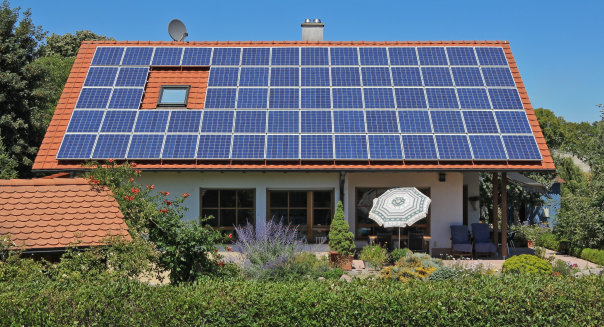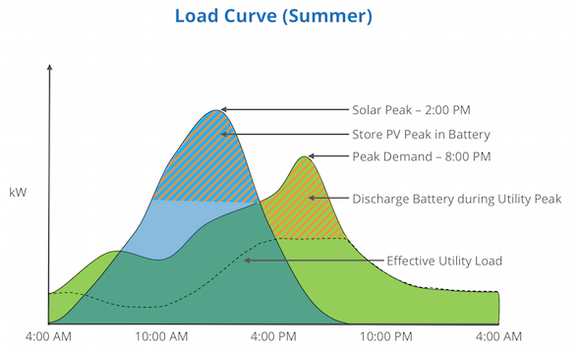
Solar power is starting to shake up the energy market as we know it, yet rooftop solar panels can only disrupt the utility industry so much. However, new developments brewing in solar could bring major changes.
Currently, the utility grid takes the extra electricity produced by rooftop solar systems during the day and provides enough electricity for solar homes to keep the lights on at night, a structure known as “net metering.” This works when a relatively small number of homes have solar panels but becomes more difficult as more homes go solar. As we pass a million solar homes in the U.S., a milestone we’ll likely hit later this year, the grid will be stretched, particularly in sunny parts of the country like California and Arizona.
But energy storage could ease the growing strain solar energy puts on the grid and make it possible for people to cut ties with the grid altogether. Energy storage could be the catalyst to make electric utilities adapt to innovations taking place in the energy space and change the way millions of people get their energy.
How Energy Storage Works
In effect, energy storage simply shifts when the utility sees demand from a solar customer. In a typical solar household, the home will actually send electricity to the grid during the day when the sun is out (blue area below) and draw electricity the rest of the day, particularly right after the end of the workday, when demand is highest (green area below).

What energy storage can do is take some of that electricity that’s created during the day, store it, and discharge it at night, all within your home. This smooths out the demand the grid sees (approximated by the dotted line in the image above).
This is important because it means solar homes won’t create the same stress on the grid as they once did, reducing a major complaint utilities have about rooftop solar. Energy storage also gives consumers choice in when and how they use electricity, which could be a selling point for consumers looking to reduce carbon emissions.
How Traditional Utilities Are Fighting Back Against Solar
Solar power usage, however, means less revenue for the utility companies. So in response, utilities have developed a strategy to fight its adoption. Instead of only charging customers for the energy they use, utilities across the country are proposing a fixed charge for every customer to connect to the grid and then a lower rate for each kWh of electricity used.
On the surface, the concept makes some sense: Each customer should have to pay something to get access to the grid, and they should pay more if they use more energy. But it’s a regressive way to charge customers, meaning the rich will in effect pay less for each kWh used.
Imagine two homes: one a small home that uses 500 kWh of electricity each month, the other a much larger home that uses 5,000 kWh of electricity each month. Then let’s say that each customer is charged $20 to access the grid and $0.10 per kWh of electricity they use. The small home would have a total bill of $70 per month and the larger home would have a bill of $520. Despite using 10 times as much electricity, the larger home’s bill is only 7.4 times that of the smaller home.
The intended side effect, however, is that it also quashes the economics of solar. If you could offset all of your electricity with a rooftop solar system but still got charged $20 to be connected to the grid, it would make less sense to go solar than if you were only charged for the net energy you use. But therein lies the problem that could upend utilities as we know them.
Where Energy Storage Could Go in the Future
Energy storage as a product is growing, but it’s still in an early phase of its existence. Right now, companies like SolarCity (SCTY) and SunPower (SPWR) that offer energy storage aren’t proposing taking homes off the grid entirely with energy storage — but that’s the logical next step. If you had a large enough energy storage system, it’s perfectly reasonable to think you could generate enough electricity to power your home with solar panels, and the energy storage system would make sure the house ran reliably.
Long-term, this is exactly what utilities don’t want to happen. They don’t want leaving the grid entirely to be an option for consumers who go solar. The problem will be creating the right rate and incentive structure to give customers freedom to get energy from where they want — while still making a profit — without alienating solar customers altogether.
Utilities that get it wrong could face major hardship. Hawaii has become the first battleground to watch. Electricity costs there are over three times the national average, making going solar a no-brainer. But the state’s main energy utility, Hawaiian Electric Industries, has been dragging its feet in connecting solar systems to the grid because it says it can’t handle the surge in electricity during the day followed by a big rise in demand at night.
Regulators are saying that’s rubbish and demanding that Hawaii’s utilities figure out a way to make rooftop solar work. If they can’t, it could be the first place in the U.S. where it’s economical to say goodbye to the grid and build a big enough energy storage system to supply your own energy 24/7.
That could be the future of energy, and if enough consumers go off-grid, it would topple utilities in the U.S. Innovation is coming to the energy business, and even utilities are going to have to keep up to survive.
•How Hawaii Residents Could Save Billions by Going Renewable
•Why Gasoline Could Be Cheap for Years to Come
•How Much Could an Electric Vehicle Save You?


Leave a Reply